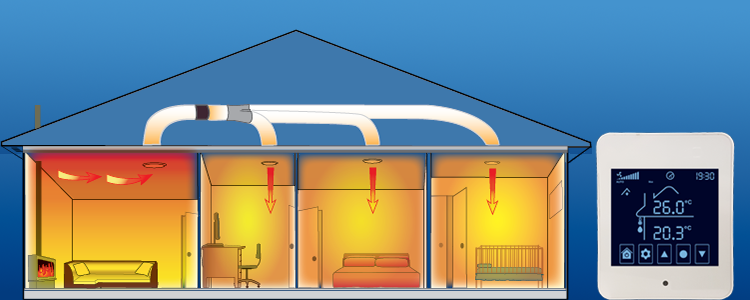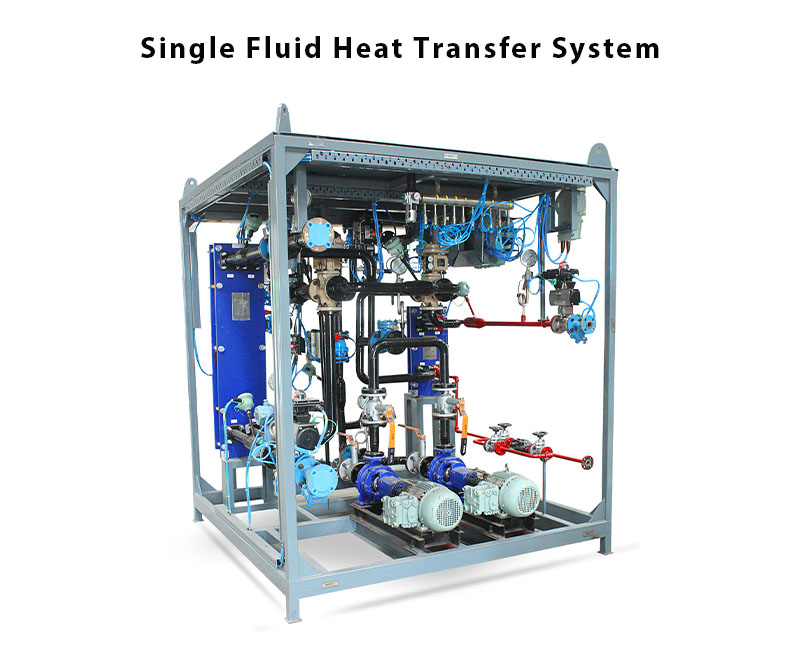Are DVS Heat Transfer Systems Built for High-Performance Electronics Cooling?
Developments in Heat Transfer Systems: What You Required to Know for Optimal Efficiency
Technologies in Heat transfer systems are changing performance throughout different sectors. Advanced materials like graphene and nanofluids guarantee substantial enhancements in thermal conductivity. The assimilation of IoT and maker knowing provides chances for real-time surveillance and enhanced power efficiency. The landscape of thermal management is swiftly advancing. Recognizing these growths is necessary for achieving excellent system performance and sustainability in the future. What particular improvements are forming this makeover?
Arising Products for Improved Heat Transfer

Advanced Heat Exchanger Layouts
While traditional Heat exchangers have offered their function in numerous applications, progressed layouts are now emerging to fulfill the enhancing demands for performance and efficiency. These ingenious layouts, such as plate, shell-and-tube, and finned-tube Heat exchangers, incorporate boosted surface and improved flow patterns to boost thermal transfer rates. Additionally, portable designs enable reduced area needs without compromising efficiency. Advanced materials, such as compounds and corrosion-resistant alloys, additionally boost sturdiness and performance under extreme conditions. In addition, simulation technologies and computational liquid characteristics are significantly used to refine these styles, guaranteeing peak Heat transfer characteristics. As industries look for to lessen energy intake and maximize output, the adoption of innovative Heat exchanger designs is pivotal in accomplishing these objectives.
The Function of Nanotechnology in Heat Transfer
Nanotechnology plays a crucial role in boosting thermal conductivity within Heat transfer systems. By controling materials at the nanoscale, scientists have attained significant enhancements in energy effectiveness. These advancements not only optimize performance but additionally contribute to even more sustainable power solutions.
Improved Thermal Conductivity
Substantial developments in thermal conductivity have emerged via the application of nanotechnology, changing Heat transfer systems throughout numerous industries. By including nanoparticles right into Heat transfer liquids and products, scientists have attained remarkable boosts in thermal conductivity. These nanoparticles, such as carbon nanotubes, graphene, and steel oxides, enhance the Heat transfer homes as a result of their high area and distinct thermal attributes. The resulting compounds exhibit enhanced performance in applications varying from electronics cooling systems to renewable energy innovations. The ability to customize the dimension, shape, and composition of nanoparticles allows for enhanced thermal monitoring remedies. As a result, nanotechnology remains to play a crucial role in the development of a lot more efficient and effective Heat transfer systems, leading the way for improved industrial applications.
Energy Efficiency Improvements

Assimilation of IoT in Heat Transfer Systems
The assimilation of IoT in Heat transfer systems presents the implementation of smart sensing units that enhance operational efficiency. These sensors make it possible for real-time data surveillance, enabling instant adjustments and optimizations. This technical development has the possible to substantially enhance performance and power monitoring in Heat transfer applications.
Smart Sensors Implementation
As Heat transfer systems progress, the assimilation of wise sensors via the Internet of Things (IoT) has become a transformative approach. These sensors allow real-time surveillance of pressure, flow, and temperature rates, improving system effectiveness and dependability. By accumulating and transmitting information, they facilitate proactive maintenance, minimizing the threat content of system failures. Furthermore, smart sensors add to power financial savings by refining functional criteria based on environmental conditions. Their capacity to examine fads and anomalies permits educated decision-making, making certain peak performance of Heat transfer systems. As industries increasingly adopt this innovation, the implementation of smart sensors stands to revolutionize exactly how Heat transfer systems are taken care of, leading the way for better sustainability and boosted performance end results.
Real-Time Information Surveillance
Exactly how can real-time information monitoring enhance the efficiency of Heat transfer systems? By integrating Net of Things (IoT) technology, Heat transfer systems can leverage continuous data collection from clever sensing units. This real-time surveillance allows for immediate analysis of pressure, flow, and temperature level rates, enabling operators to identify ineffectiveness promptly. Modifications can be made to maximize performance, minimize energy consumption, and prolong equipment life-span. Furthermore, predictive upkeep can be carried out, lessening unanticipated downtime and expensive repairs. The discover this ability to imagine performance metrics via control panels enhances decision-making, promoting a proactive strategy to system administration. Ultimately, real-time data keeping an eye on not only enhances functional effectiveness but likewise adds to sustainability goals within commercial processes.
Power Efficiency and Sustainability Trends
Power performance and sustainability trends are improving the landscape of Heat transfer systems, driving advancement and compliance throughout various sectors. Organizations are increasingly focusing on energy-efficient designs to lower operational prices and reduce ecological impacts. The assimilation of renewable power resources is coming to be more widespread, enabling Heat transfer systems to operate sustainably while satisfying regulative requirements. In addition, developments in technologies and materials promote lower power usage and boost overall efficiency. Lifecycle assessments are additionally gaining traction, permitting companies to examine the ecological effect of Heat transfer systems from production to disposal. This focus on sustainability not only supports corporate obligation yet additionally positions organizations competitively in a market where customers significantly prefer environment-friendly solutions. Consequently, power performance and sustainability stay critical factors to consider for future developments in Heat transfer technology.
Innovations in Thermal Monitoring Solutions
While the need for reliable Heat transfer remains to climb, advancements in thermal management remedies are arising to attend to both performance and sustainability difficulties. Advanced materials, such as stage change products and nanofluids, are being established to improve Heat transfer performance - DVS Heat Transfer Systems. These products boost thermal conductivity and permit better temperature level regulation in numerous applications. Furthermore, modern technologies like active thermal control systems are obtaining grip, allowing real-time adjustments to take care of Heat flow properly. These systems contribute to energy financial savings and lower the environmental impact of thermal processes. In addition, the combination of IoT in thermal management helps with monitoring and anticipating upkeep, making sure optimized performance and longevity of Heat transfer systems. In general, these developments stand for substantial strides toward even more lasting thermal management techniques
Future Instructions in Heat Transfer Technology
Emerging developments in thermal management remedies indicate a promising future for Heat transfer technology. Researchers are progressively concentrating on developing materials with premium thermal conductivity and enhanced energy performance. Technologies such as nanofluids, which include suspended nanoparticles, supply considerable renovations in Heat transfer performance. In addition, the integration of wise products that adapt to differing temperature level problems is obtaining traction, permitting for more reliable and receptive systems. The surge of additive manufacturing methods is additionally making it possible for the style of complicated Heat exchanger geometries that enhance fluid flow. The implementation of machine learning algorithms is anticipated to transform the optimization of Heat transfer systems, assisting in predictive maintenance and performance enhancement. Collectively, these developments are positioned to change the landscape of Heat transfer innovations in different sectors.

Frequently Asked Concerns

How Do I Select the Right Heat Transfer System for My Application?
Choosing the appropriate Heat transfer system entails assessing application demands, consisting of temperature arrays, fluid buildings, and efficiency requirements. Examining system kinds, upkeep factors to consider, and cost-effectiveness additionally plays a vital function in making an educated choice.
What Are the Maintenance Demands for Advanced Heat Exchangers?
Maintenance demands for sophisticated Heat exchangers generally consist of routine examinations, monitoring for leakages, cleaning of surfaces, and guaranteeing ideal circulation prices. Sticking to maker guidelines here are the findings warranties reliable procedure and lengthens the equipment's life expectancy.
Exactly How Do Environmental Variables Affect Heat Transfer Performance?
Environmental factors considerably affect Heat transfer effectiveness. Variations in temperature level, air flow, and humidity effect thermal conductivity and convective Heat transfer, inevitably impacting system performance and requiring factor to consider during the layout and procedure of Heat transfer systems.
What Safety And Security Criteria Put On Heat Transfer Solutions?
Safety and security standards for Heat transfer systems usually include standards from companies such as ASME and ASTM. DVS Heat Transfer Systems. These requirements address materials, design, and operational methods to ensure integrity, performance, and defense against risks in numerous applications
Just How Can I Repair Common Heat Transfer System Issues?
Repairing usual Heat transfer system concerns involves looking for leaks, making certain appropriate fluid flow, evaluating insulation integrity, and verifying temperature differentials. Recognizing these aspects can assist maintain system efficiency and stop additional complications.
Nanotechnology plays a necessary duty in boosting thermal conductivity within Heat transfer systems. Significant developments in thermal conductivity have emerged through the application of nanotechnology, reinventing Heat transfer systems across various industries. Innovations in thermal conductivity with nanotechnology have actually led the method for impressive renovations in power effectiveness within Heat transfer systems. Energy efficiency and sustainability trends are improving the landscape of Heat transfer systems, driving advancement and conformity across numerous markets. The assimilation of IoT in thermal monitoring promotes monitoring and anticipating upkeep, ensuring maximized performance and longevity of Heat transfer systems.